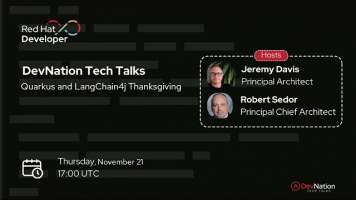Developer Events
Join us for online events and event tutorials, or attend regional events held around the world—you'll meet peers, industry leaders, and Red Hat's Developer Evangelists and OpenShift Developer Advocates.
Explore the developer community with our lineup of DevNation events.
Upcoming events
Connect virtually and in-person with DevNation
Join us online from anywhere in the world, or in person at events held all year long. You'll meet peers, industry leaders, and Red Hat's team of developer evangelists.

Most recent DevNation content








